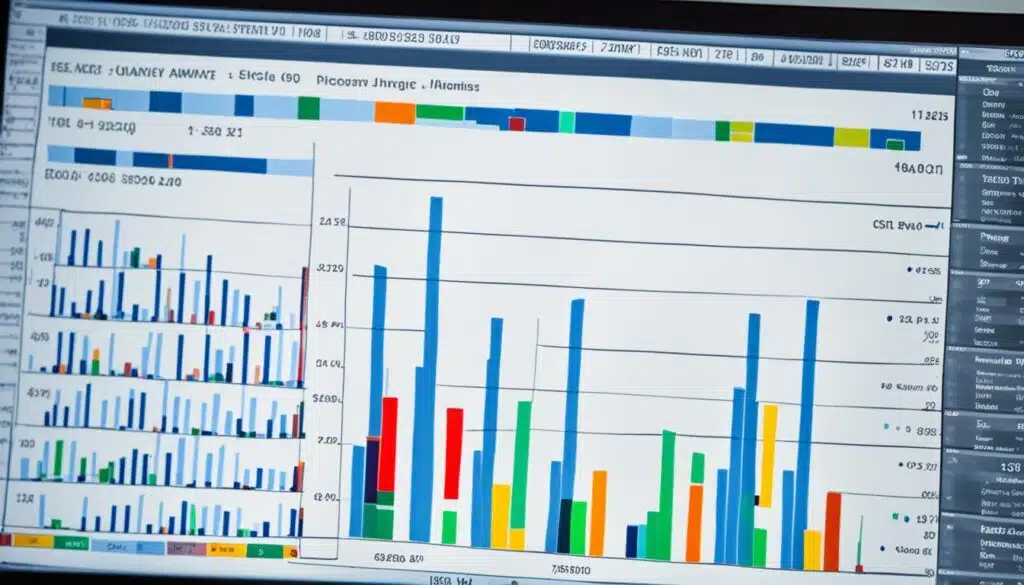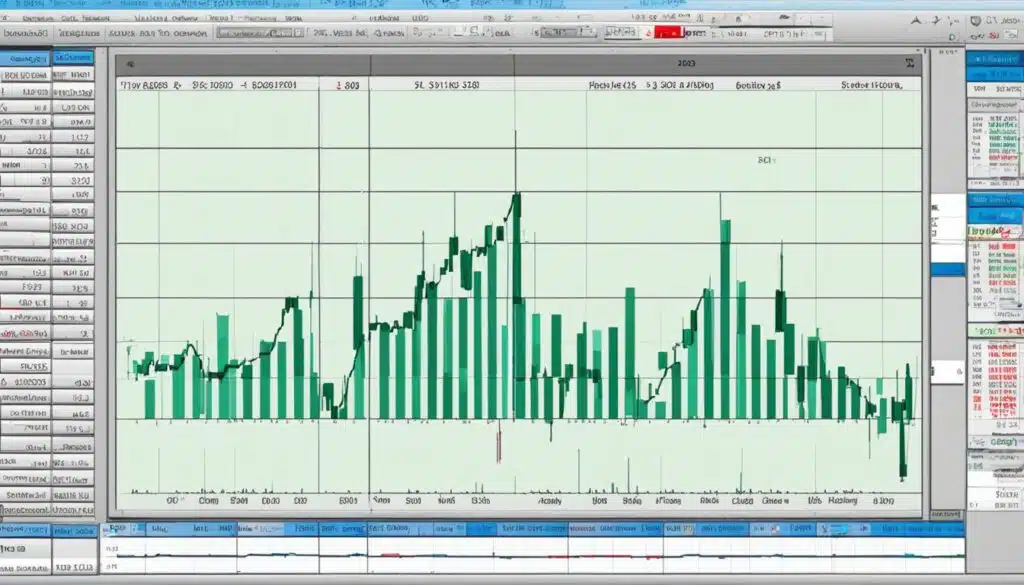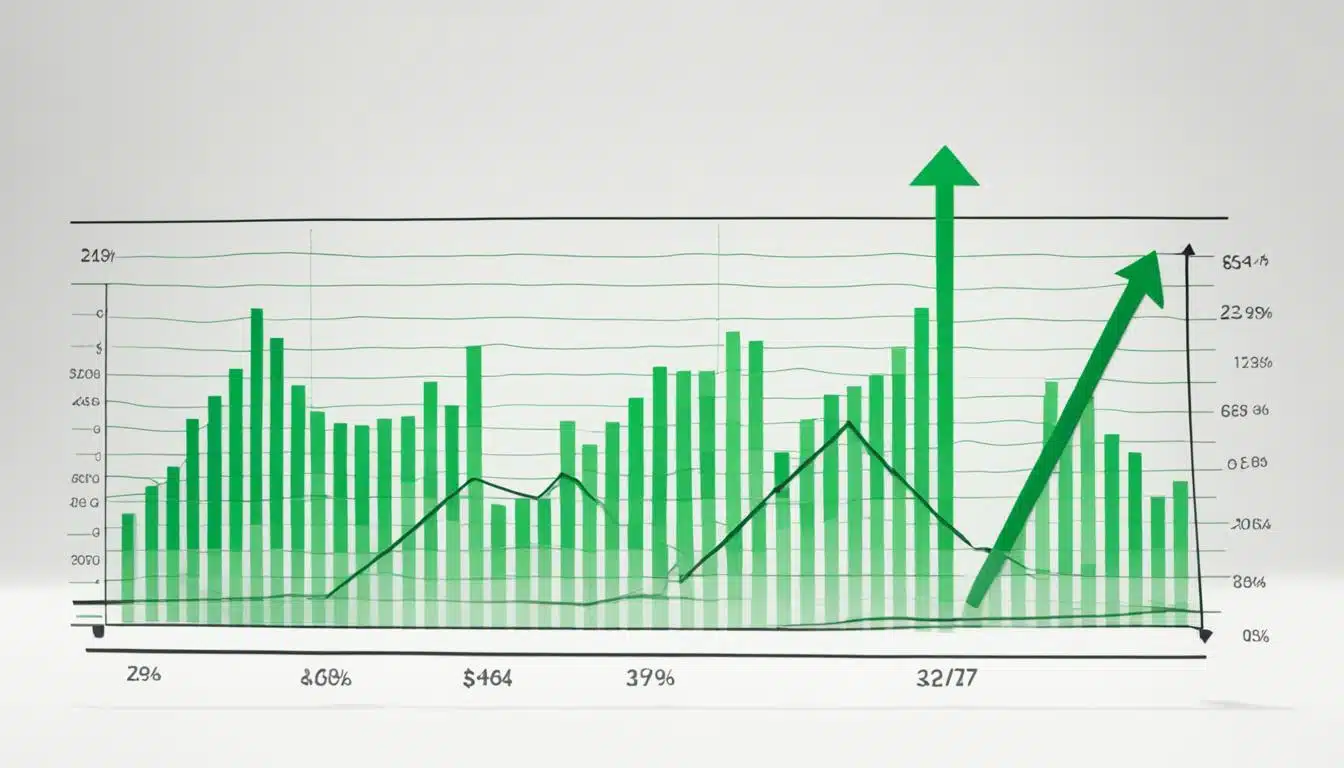Stock market graphs are like pictures of how stock prices move, how many are traded, and more. They show if a stock is going up, down, or staying the same. You can see these data in line charts, bar charts, and candlestick charts. Each chart type tells a different story about stock prices. Knowing how to understand them is key to making smart trades.
Traders and investors find stock market graphs very helpful. They show a lot of information at a glance. It’s simple to spot trends and key levels that can help in making trading choices. Learning about charts, from simple lines to detailed candlesticks, is important. It helps you deal with the challenges of the stock market better.
Key Takeaways
- Stock market graphs provide visual representations of equity prices, trading volumes, and technical indicators.
- Understanding different chart types, such as line charts, bar charts, and candlestick charts, is crucial for effective trading strategies.
- Analyzing stock market graphs can help identify trends, support and resistance levels, and other patterns that inform trading decisions.
- Mastering the interpretation of stock market graphs is a valuable skill for traders and investors seeking to navigate the stock market effectively.
- Stock market graphs offer a comprehensive view of financial data, enabling users to make informed decisions based on visual representations of market behavior.
Introduction to Stock Market Graphs
Learning about stock prices helps with technical analysis. Stock market graphs visually show this data. They let traders and investors spot trends and key levels. This knowledge can improve their trading plans.
Understanding Price Movements
Stock price behavior is crucial for technical analysis. Graphs reveal the ups and downs of the markets. Understanding the price movements in these charts gives traders insights into market forces.
Importance of Visual Representation
The stock market graphs‘ visual aspect is advantageous. Technical analysis needs quick pattern spotting. This is made easier with line charts, bar charts, and candlestick charts. These visuals help traders make better decisions and plan effectively.
Common Types of Stock Charts

When looking at the stock market, people use various charts to understand how prices move. The main types are line, bar, and candlestick charts. Each shows details and trends in its own way.
Line Charts
Line charts are simple but great for showing stock trends. They draw a line from one closing price to the next over time. This makes it easy to see how stock prices have changed. They help find trends and important price levels.
Bar Charts
Bar charts are also a top pick for stock data. They use bars to show the range of prices within a period. The start of the bar is the opening price, and the end is the closing one. Bar charts let traders examine daily price movements, which is key for spotting market trends and key prices.
Candlestick Charts
Candlestick charts are full of information and look cool too. Each candlestick tells the story of a period’s price movement. The candle’s color, wick, and body show the price range and if it was a good or bad time for the stock. They help find turning points and trends.
Learning about these charts helps traders and investors. It makes them smarter at reading the market and choosing their next moves.
stock market graphs

Stock market graphs show a lot about stock prices. Each chart type helps investors in different ways. Line charts are easy to read. Bar charts and candlestick charts provide more detailed info. They help people understand trends, feelings in the market, and what prices are doing.
Line Charts: Simplicity and Trend Visualization
Line charts make stock price changes clear. They’re great at showing trends. This helps figure out if prices are going up, down, or staying the same. It’s a good starting point for anyone looking at the market.
Bar Charts: Displaying Price Ranges
Bar charts give a lot of info about price movements. They show the opening, highest, lowest, and closing prices. This helps understand market feelings and if it’s a good time to buy or sell. Bar charts also highlight important levels and possible changes in trends.
Candlestick Charts: Bullish and Bearish Sentiment
Candlestick charts are great for showing if the market is bullish (positive) or bearish (negative). They use candle shapes to represent prices over a period. This makes it easier to spot key patterns. These patterns can help with buying and selling stocks.
Reading and Interpreting Stock Charts
Understanding stock market graphs helps traders and investors a lot. It lets them spot important patterns. One key part is noticing if the trend is going up or down.
Identifying Uptrends and Downtrends
Seeing an uptrend means prices are making higher highs and higher lows. This shows a positive mood among investors. A downtrend, on the other hand, shows lower highs and lows. It tells us that many are feeling negative about the market.
Finding these trends is vital. It helps make better choices and keeps your strategies in line with the market.
Support and Resistance Levels
It’s also important to look for support and resistance points on the charts. Support points are where demand from buyers is strong, which can stop a falling price. Resistance points are where there’s a lot of sellers. This might keep prices from rising further.
Knowing these levels is crucial. They can guide decisions on when to buy or sell. They also play a part in managing risk.
Breakouts and Reversal Patterns
Stock charts also show breakouts and reversal patterns. A breakout happens when a stock price moves past a key level. This could mean the trend is changing. Patterns like head and shoulders or double top/bottom can show a turning point in the market.
When you understand these basics of technical analysis, you can read stock market graphs better. This knowledge helps you make smarter choices.
Technical Indicators and Chart Overlays

Traders and investors have many tools to understand stock movements better. These include technical indicators and chart overlays. They show trends, find support and resistance levels, and point out when stocks are overbought or oversold.
Moving Averages: Simple and Exponential
The moving average is a key indicator for seeing the stock’s general trend, cutting out the daily ups and downs. There’s the simple moving average (SMA) and the exponential moving average (EMA). These are the ones traders often turn to for studying the market’s price action and trend confirmation.
Oscillators: RSI and MACD
Oscillators, like the Relative Strength Index (RSI) and the Moving Average Convergence Divergence (MACD), spot when stocks are overbought or oversold. They also help find potential market momentum shifts.
Volume Analysis
Volume analysis is crucial for understanding market movements’ strength. When traders look at trading volume alongside price changes, they can gauge the force behind these moves. This helps them make wiser decisions.
Advanced Chart Patterns and Formations

Stock market graphs go beyond basic types and indicators. They show complex patterns useful for traders and investors. Key patterns include the head and shoulders, the cup and handle, and various triangle shapes.
Head and Shoulders Pattern
This pattern signals a possible change in market mood. It has a ‘head’ at the highest point and ‘shoulders’ lower on each side. When the price breaks below the ‘neckline,’ it often heads downward. The distance from the neckline to the head’s top is a common measure of this movement.
Cup and Handle Pattern
The cup and handle is a shape that suggests prices might go up. First, the price forms a ‘cup’ like a ‘U’. Then, it has a small dip, making the ‘handle’. A move up after breaking above the handle could mean more gains ahead.
Triangle Patterns
Triangles, like symmetrical, ascending, and descending, can show future price moves. The way the lines converge can predict if prices will keep going, change, or go the opposite way.
Knowing these patterns helps traders and investors improve their analysis. But, always use these tools with other indicators and market data for smart investing. Don’t rely on patterns alone for your decisions.
Combining Indicators and Chart Patterns

In technical analysis, the power of stock market graphs is best seen when combining indicators and chart patterns. This method helps traders and investors find reliable trading signals, spot market trends, and handle risk well.
Using combining indicators and chart patterns makes us fully understand technical analysis. It gives a strong base for decision-making. Traders can confirm trends and craft solid trading strategies this way.
| Indicator | Chart Pattern | Potential Insights |
|---|---|---|
| Moving Averages | Head and Shoulders | Identify potential trend reversals and confirm market trend confirmation. |
| MACD | Cup and Handle | Detect momentum shifts and trading signals for entering or exiting positions. |
| RSI | Triangles | Pinpoint overbought and oversold conditions and identify potential breakouts or reversals. |
Combining indicators and chart patterns gives traders a full view of the market. It makes risk management better and supports smart trading decisions.
Trading Strategies Using Stock Charts
Stock market graphs help us study how individual stocks behave. They are also key to many trading strategies. Traders use these charts to spot patterns and trends. This helps them craft their way through the markets.
Trend Following Strategies
One top method is trend following using stock charts. This means finding and using market trends for profit. If they see a clear trend up or down, they make moves to match it. Success depends on managing risk and the size of their positions well.
Reversal Trading Strategies
Reversal trading looks for when the market might turn. Traders check stock charts for signs that the market mood could change, or a trend reversal might happen. They aim to profit from the market going up or down. Technical analysis, like reading chart patterns and using indicators, is key here.
Using stock charts and technical indicators well can help traders. It makes decisions smarter, minimizes risks, and boosts chances of success. Diversifying and using a mix of strategies can lead to better outcomes over the long haul.
Also Read : Short-Term Vs Long-Term Prognosis In Severe Infectious Diseases
Choosing the Right Charting Tools and Software
Getting into stock market graphs means choosing the best tools is very important. The right platform makes it easier to study data, spot trends, and trade well.
Online Charting Platforms
Traders and investors today often choose online platforms. Options like TradingView and StockCharts.com provide lots of technical help and let users share insights. They give current data and work on many devices.
Desktop and Mobile Applications
Others might like the power of desktop and mobile apps. NinjaTrader, AmiBroker, and MetaStock have many advanced tools. They’re for people wanting the most from their technical analysis and strategies.
The software you pick should match your trading style and needs. No matter if you go with online or desktop solutions, it’s about what helps you achieve your trading goals best. Look for something that fits well, is easy to use, and helps you make smart stock market moves.





